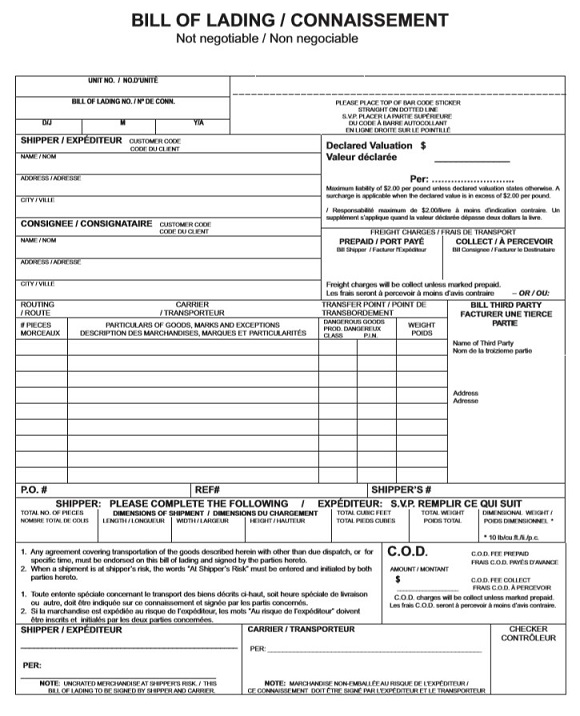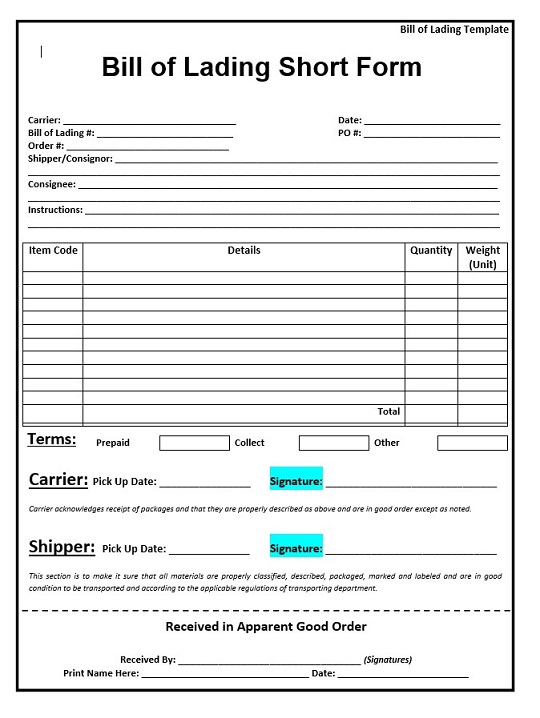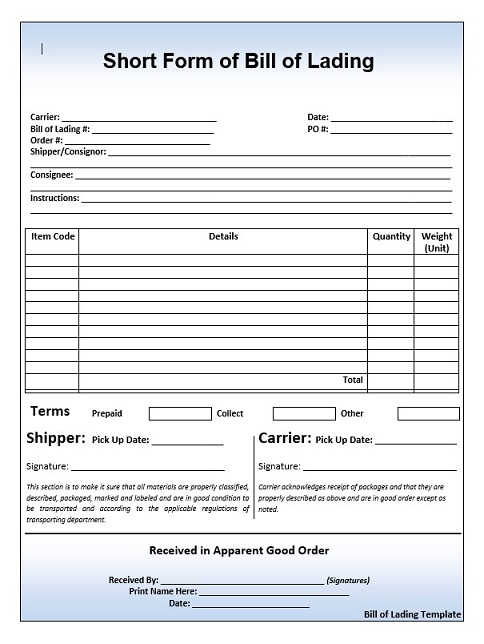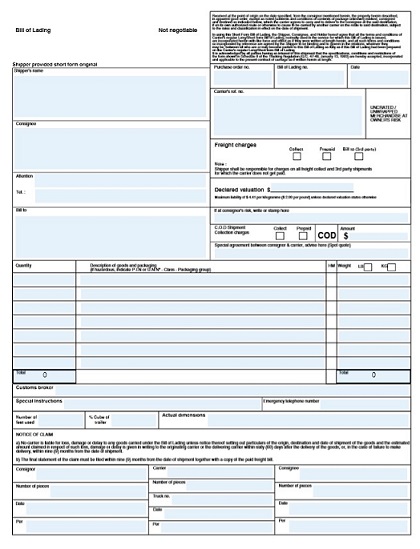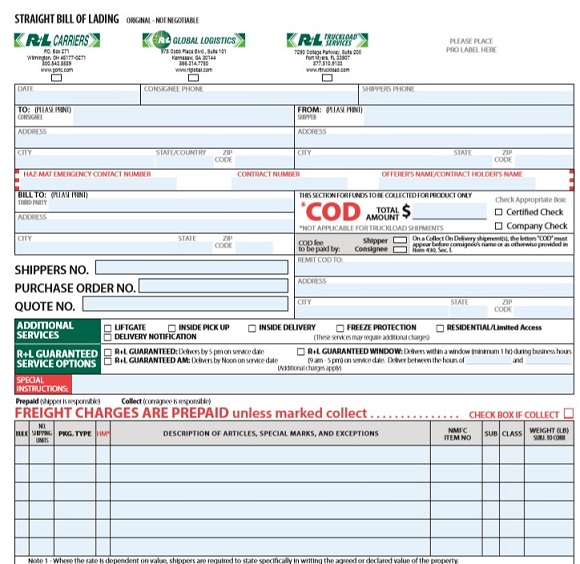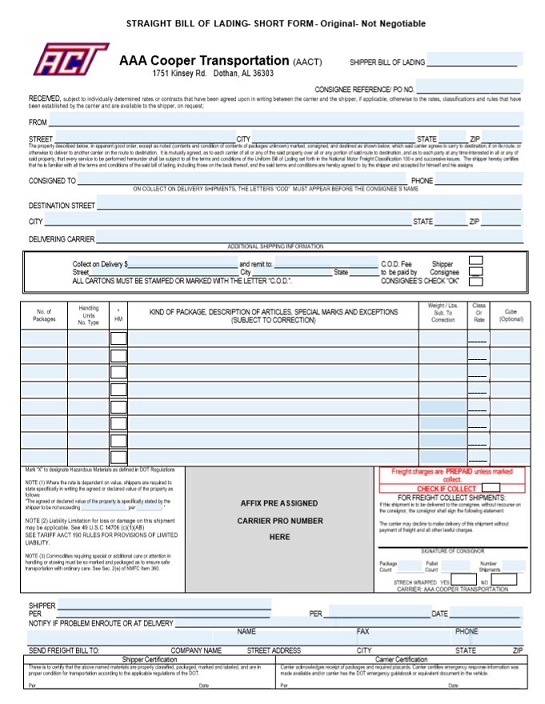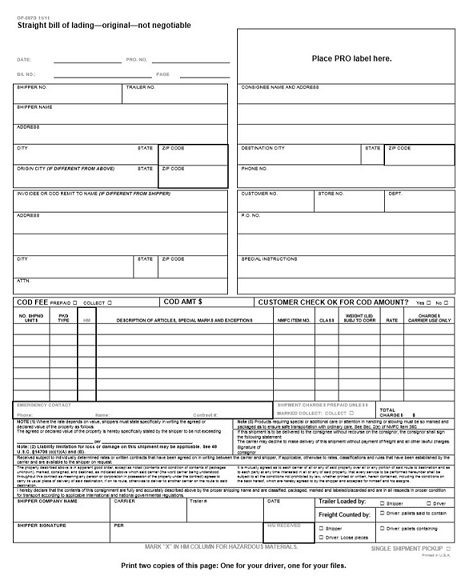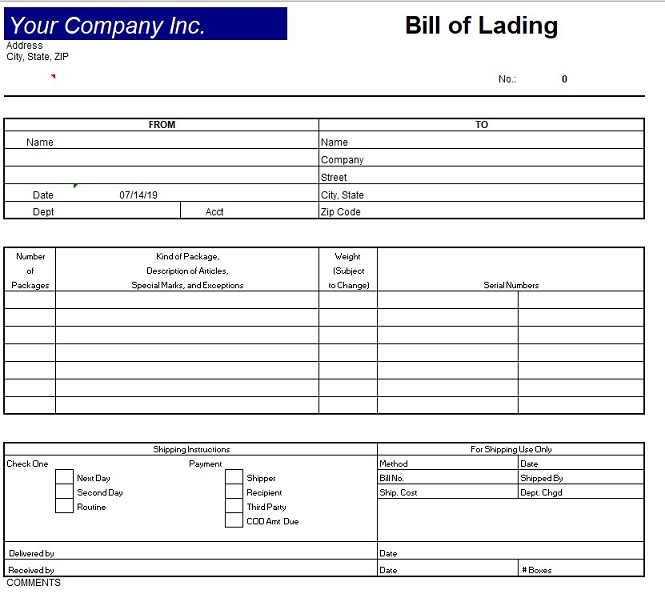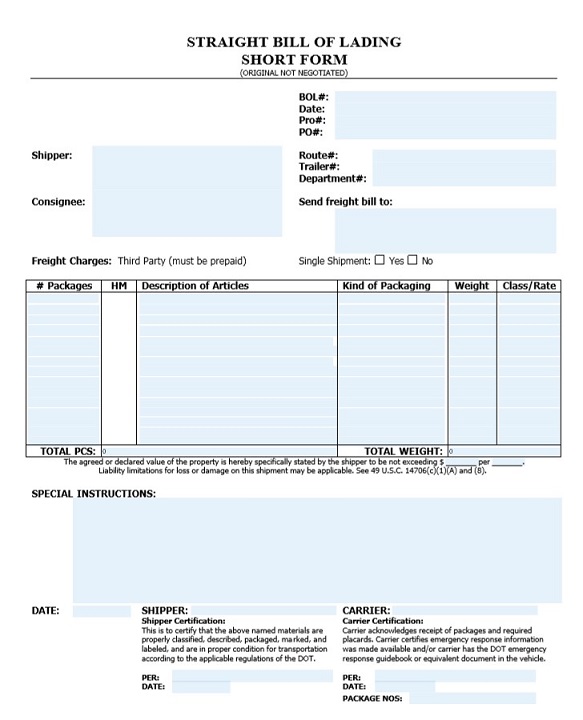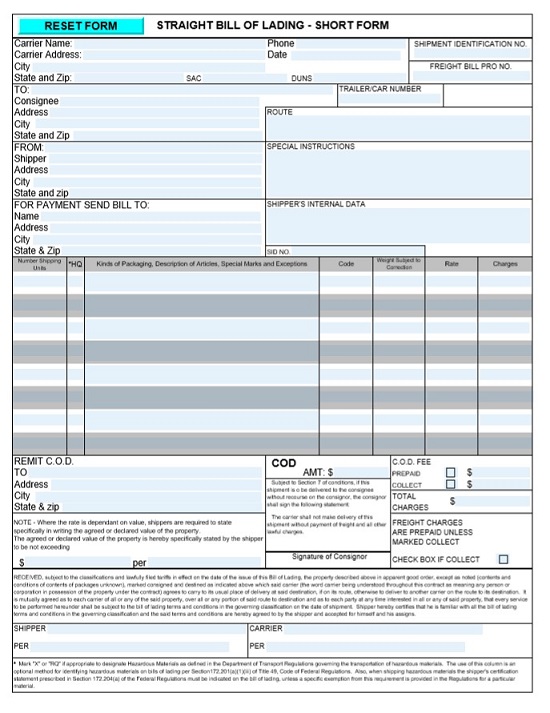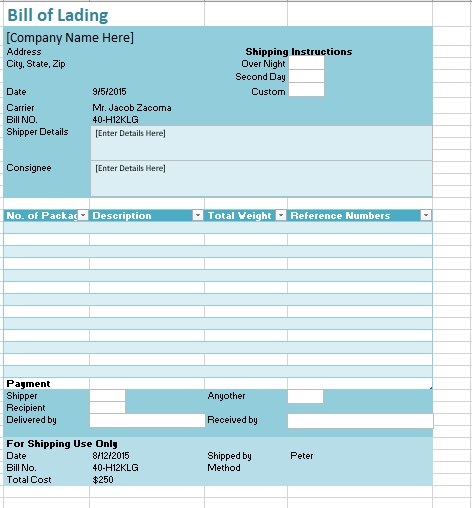Many business owners often deal with international shipping, which might use the simple bill of lading form. It was considered one of the most important documents for shipping transportation. Highlight all necessary information about your package, shipping method, and where it comes from. You should know that this form can be used as evidence of receipt. If you need a bill, you only need to download free templates and save time. Besides that, it also has some types and purposes to be played. Let’s learn more about It!
Types of bill of lading
Here are some types of bills of lading:
Shipped bill of lading
It is one of the most common bill-of-lading template types. Sometimes, the sender might ask that the shipowner provide this form as evidence that the goods have shipped already. That’s why this form should be printed in advance. Those documents often stated that the goods were delivered in good condition. It decides and confirms that the goods are really on board. It is the most common receipt used by the shipper.
Ocean Bill of Lading
This document type is needed when the transporter moves the cargo across the international or national ocean. It is used as both, and it can be negotiated or not. The non-negotiable will allow the buyer to receive the goods when they show their identifications. Conversely, the negotiable form will ask the shipper to check the goods and negotiate with the seller. This bill of lading sample allows the sender to send goods abroad.
Through Bill of Lading
It is also a very common form, but it’s pretty complex. This type allows the shipping carrier to bring the cargo receipt using different methods and distributions of transportation. This method also allows to transport the goods internationally and domestic borders as well. This document highlights the amounts and types of goods that should be transported tell the shipper for its destination.
Inland Bill of Lading
It is another necessary document for cargo transportation. However, this form is different from the ocean bill. It was needed for the goods that should be transferred to the land.
Negotiable Bill of Lading:
BOL can be transferred from one person to another. It’s often used when goods are sold while they’re still in transit. The holder of this BOL has the right to claim the goods or even sell them to someone else by endorsing the BOL.
Non-negotiable Bill of Lading
This BOL doesn’t allow the transfer of ownership of the goods in transit. It’s a direct shipment to the person named on the BOL. They’re the only ones who can claim the goods.
Claused Bill of Lading
Also known as a “dirty bill of lading,” this BOL indicates that goods were damaged when loaded or that the shipment didn’t follow certain terms in the shipping agreement. It can affect the seller’s payment if goods are sold pending delivery.
Clean Bill of Lading
This is the opposite of the claused BOL. It states that goods were in good condition when transported to the carrier. It’s the most preferred type for sellers as it assures payment upon delivery.
Uniform Bill of Lading
This is a standardized BOL used in the domestic transportation of goods. It sets a consistent set of terms and conditions for shipping, making it simpler and clearer for all parties involved.
Understanding the Bill of Lading
When people send or get things using ships or trucks, they use a special paper called a Bill of Lading. This paper is very important. Let’s see why:
1. A Proof Paper:
The Bill of Lading is like a promise. It shows that the people who move the goods have taken them and will take good care of them. This paper helps people trust each other when sending things.
2. Makes Things Clear:
This paper also tells everyone about the goods. It says what the goods are, how many there are, and how they should look. So everyone knows what to expect.
Elements to Include in the Bill of Lading
A Bill of Lading (BOL) is crucial in shipping and logistics. To make sure that the BOL is comprehensive and serves its purpose, it should contain the following elements:
- Shipper and Consignee Details:
- Shipper’s Name and Address: Details of the person or company sending the goods.
- Consignee’s Name and Address: Information about the person or company receiving the goods.
- Carrier Details:
- Name and Address: Details of the company responsible for transporting the goods.
- Contact Information: Including phone number and email address.
- Freight Payment:
- Information about who will pay for the shipping costs. It can be the shipper, the consignee, or a third party.
- Description of Goods:
- Type of Goods: What is being shipped, e.g., electronics, clothing, machinery.
- Quantity: The number of items or packages.
- Weight: The total weight of the shipment.
- Dimensions: The size of the goods or the package is often important for shipping costs.
- Special Instructions: Any specific handling instructions, especially for fragile or hazardous materials.
- Pickup and Delivery Details:
- Pickup Date: When the goods were collected.
- Expected Delivery Date: When the goods are expected to reach their destination.
- Place of Receipt: Where the goods were collected from.
- Final Destination: Where the goods will be delivered.
- Freight Charges:
- Detailed breakdown of the transportation costs, including any additional fees or services.
- Special Instructions:
- Any additional instructions for the carrier, like temperature control or secure storage?
- Tracking Number or Reference:
- A unique number to track the shipment’s progress.
- Terms and Conditions:
- The legal terms guiding the transportation, including liabilities, claims, and responsibilities of all parties.
- Signatures:
- Shipper: The person or company sending the goods.
- Carrier: The transportation company representative.
Advantages of Using a Bill of Lading Template
One of the cornerstone documents in this industry is the Bill of Lading. This official document acts as a receipt for goods, a contract between the shipper and the carrier, and a title document.
Given its multifaceted role, precision and clarity are of the essence. It is where the use of a Bill of Lading template steps in. Let’s delve into the advantages of utilizing such a template:
1. Consistency Across Shipments
Using a template ensures that every shipment adheres to a consistent format. This uniformity benefits both the shipper and the receiver as they become accustomed to the layout, making information processing quicker and more efficient.
2. Time-saving
Drafting a new document each time can be tedious. With a ready-to-use template, businesses can quickly fill in the required details, accelerating the shipping process and ensuring that every shipment is completed on time due to paperwork.
3. Reduced Errors
Manual creation can be prone to human errors, from typos to omissions. A template minimizes these mistakes, as most fields are predefined, ensuring that critical data isn’t overlooked.
4. Cost-Effective
Time is money. By reducing the time spent drafting documents and correcting errors, businesses can channel their resources and workforce to other vital areas, optimizing costs.
5. Standardization
For businesses operating across different regions or countries, templates can help standardize documentation. It is especially crucial when dealing with international shipments, where discrepancies can lead to delays or legal complications.
6. Enhanced Legibility
Templates are typically designed to be clear and easy to read. This clarity is crucial in ensuring that all parties involved – from the shipper to the customs officer – can quickly glean the necessary information.
7. Easy Digital Storage and Retrieval
With digital templates, businesses can store and retrieve past Bills of Lading. This digital archive is invaluable for reference, audits, or in case of disputes.
8. Facilitates Training
For new employees in the shipping department, a standardized template simplifies training. New staff can quickly understand the format, required information, and how to fill it out.
Important Details for the Bill of Lading Template
When you send things from one place to another, like how you book a flight for a trip, you use a paper called the Bill of Lading. This paper is like a travel plan for the things you send. It tells everyone where things are going and how they will get there. Here are the important things that should be on that paper:
1. People and Groups Involved:
- Who’s Sending and Getting: This is about the person or company sending the goods and the one getting them.
- Who Made the Paper: The company or person first made this travel plan.
- Who Pays for the Trip: This tells who is paying for sending the things.
- Helping Hand: There’s a person called a “freight forwarder.” This person helps in sending the goods. It can be the person who buys or sells the stuff.
- The Helper at the End: When things reach where they need to go, someone helps get them. This person’s name should be on the paper.
2. Details About the Things Being Sent:
- Where Are They Going: The paper should tell where the things will end up.
- Starting Point: It should also say where the things are being sent from.
- The Road They Take: Just like when we travel, it’s good to know the way. It tells which way the goods will go.
- When Will They Travel: This is like a travel date. It tells when the goods will start their trip.
- How They Travel: This tells if the goods will go by truck, ship, plane, or train.
When and Where to Use Different Bill of Lading Forms
Shipping goods involves many decisions. One crucial choice is picking the right Bill of Lading (BOL) form. The BOL you use depends on how and where you’re sending things. Here’s a guide to help you choose:
- Straight Bill of Lading:
- When to Use: Use this when sending items the buyer has already paid for.
- Description: This BOL is a direct promise that the goods will go straight to the person who bought them without changes.
- To Order Bill of Lading:
- When to Use: When the goods’ ownership might change while moving.
- Description: This special paper lets people pass the ownership of the goods to someone else. For example, a bank might be involved in helping with the payment.
- Inland Bill of Lading:
- When to Use: When sending goods by train or truck, but not by sea.
- Description: It’s like a starting paper for big trips, especially if the items travel by sea or air later. You can also download a handy version of this paper for free.
- Ocean Bill of Lading:
- When to Use: For items that will travel across the big ocean.
- Description: This paper can be straight, where the goods go directly to the buyer. Or it can be a “to order” one, where the ownership might change during the trip. And there’s a free version you can download.
- Air Waybill (AWB):
- When to Use: When sending items by plane.
- Description: This is like the Ocean Bill of Lading but for the sky! The big difference is that the ownership can’t change while the goods fly. You can also get a free version of this paper.
- Multimodal Bill of Lading:
- When to Use: The goods will travel in different ways, like by truck, then by plane, then by ship.
- Description: This is for mixed trips. For example, toys made in the middle of the USA might drive to the coast, fly over the ocean, and then sail to Europe.
Simple bill of lading form
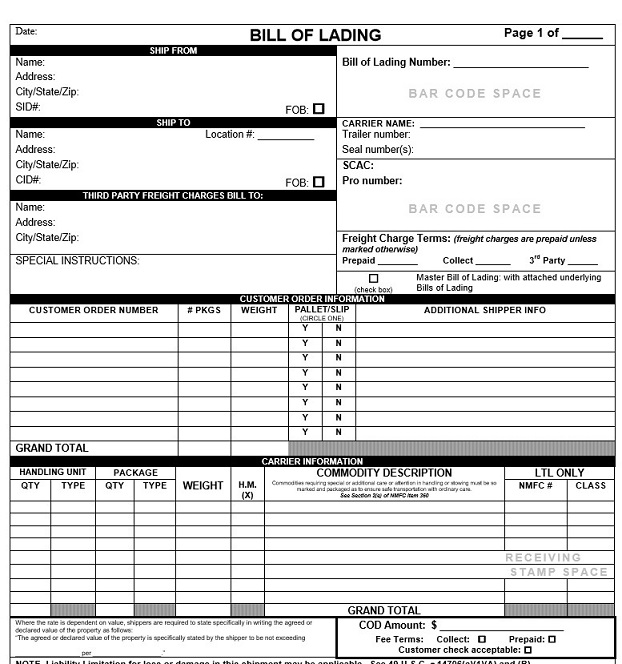
Bill of lading form example
Bill of lading Short form
Short form bill of lading
bill of lading form printable
How to Fill Out a Bill of Lading (BOL)
Filling it out is essential to ensure a smooth shipping process. Here’s a step-by-step guide:
- Shipper and Consignee Details:
- Shipper’s Information: Write the full name, address, and contact details of the person or company sending the goods.
- Consignee’s Information: Write the full name, address, and contact details of the person or company receiving the goods.
- Carrier Details:
- Enter the name of the transportation company.
- Provide the carrier’s address and contact information.
- Freight Payment:
- Indicate who will be paying for the shipping. It can be the shipper, the consignee, or a third party.
- Specify any special payment terms if necessary.
- Description of Goods:
- Type of Goods: Clearly describe the items being shipped.
- Quantity: Indicate the number of items or boxes.
- Weight: Specify the total weight.
- Dimensions: If applicable, mention the size of each package or crate.
- Special Instructions: Mention any special handling or care instructions, especially for fragile or perishable items.
- Pickup and Delivery Information:
- Date of Pickup: State when the goods were or will be collected.
- Expected Delivery Date: If known, provide the expected arrival date.
- Place of Origin: Mention where the goods are being sent from.
- Destination: Indicate where the goods are being sent to.
- Freight Charges:
- Detail the costs associated with the shipment, including any additional services or fees.
- Special Instructions or Remarks:
- Provide any additional instructions for the carrier or notes about the shipment that has yet to be mentioned elsewhere on the form.
- Tracking or Reference Number:
- If the carrier provides a tracking number, it might be pre-printed on the BOL or added once the shipment is underway.
- Terms and Conditions:
- Review the terms and conditions provided by the carrier. These often come pre-printed on the back or bottom of the BOL.
- Signatures:
- Shipper: The person or company sending the goods should sign, confirming the correct details.
- Carrier: A representative from the transportation company should also sign, acknowledging receipt of the goods.
Common Mistakes to Avoid in a Bill of Lading
Here are some common mistakes made and how to avoid them:
- Incorrect or Incomplete Shipper/Consignee Information:
- Mistake: Missing or wrong address, name, or contact details.
- Solution: Double-check all details against order forms or directly with the parties involved.
- Vague Description of Goods:
- Mistake: Providing unclear or generic descriptions.
- Solution: Ensure descriptions are specific, detailing the exact nature, type, and characteristics of the goods.
- Misstating Quantity or Weight:
- Mistake: Listing wrong quantities or weights of items.
- Solution: Use calibrated weighing tools and always cross-check quantities with order details.
- Omitting Special Handling Instructions:
- Mistake: Not specific instructions for fragile, perishable, or hazardous items.
- Solution: Always highlight special handling needs clearly and prominently on the BOL.
- Incorrect Freight Classification:
- Mistake: Misclassifying goods, leading to incorrect freight charges.
- Solution: Familiarize yourself with freight classifications and ensure the correct class is applied.
- Not Specifying Freight Payment Terms:
- Mistake: Leaving out who is responsible for freight documentation charges.
- Solution: Indicate if the shipper, consignee, or a third party is responsible for payment.
- Ignoring the Terms and Conditions:
- Mistake: Not reading or understanding the terms, leading to disputes later.
- Solution: Always review and ensure clarity on all terms and conditions. Consult a legal expert if unsure.
- Failure to Obtain Necessary Signatures:
- Mistake: Missing signatures, making the BOL non-binding.
- Solution: Always ensure all necessary parties sign the document before proceeding.
- Relying Solely on Digital Copies:
- Mistake: Not having a physical copy of the BOL when required.
- Solution: While digital is becoming the norm, always have printed copies on hand, especially for international shipments that might be required.
- Not Updating BOL Templates Regularly:
- Mistake: Using outdated templates that need to reflect current regulations or business practices.
- Solution: Review and update your BOL templates to align with industry standards and legal requirements.
FAQs
Do I always need a BOL when shipping things?
Most of the time, yes. Especially if you’re sending goods for business or over long distances, it keeps everything clear and safe for everyone involved.
Who should keep a copy of the Bill of Lading?
All main people involved should have a copy. It includes the person or company sending the goods, the one getting them, and the carrier moving them.
What happens if there’s a mistake on the BOL?
Mistakes should be fixed as soon as they’re found. A correct BOL can prevent problems with the shipment. If there’s an error, it’s best to talk to the carrier or a shipping expert immediately.
Can I make my own Bill of Lading?
There are templates you can use to make a BOL. But it’s a very important paper, so getting help or advice from someone who knows about shipping documentation
is a good idea.
Is a Bill of Lading the same as a shipping label?
No, they’re different. A shipping label is a sticker on a package that tells where it’s going. A BOL paper gives much more details about the whole shipment.
What if I lose my Bill of Lading?
If lost, it’s important to tell the carrier immediately. They might be able to help. Keeping a copy in a safe place is also a good idea.
Can the BOL be digital, or must it be on paper?
Nowadays, many companies use digital BOLs. They work just like paper ones but are stored on a computer. It’s more eco-friendly and can be easier to keep track of.

The content creator team at calipsotree.com is dedicated to making topics accessible to everyone, with over 9 years of experience in writing and breaking down complex concepts into easy-to-understand articles that answer readers’ financial questions.






